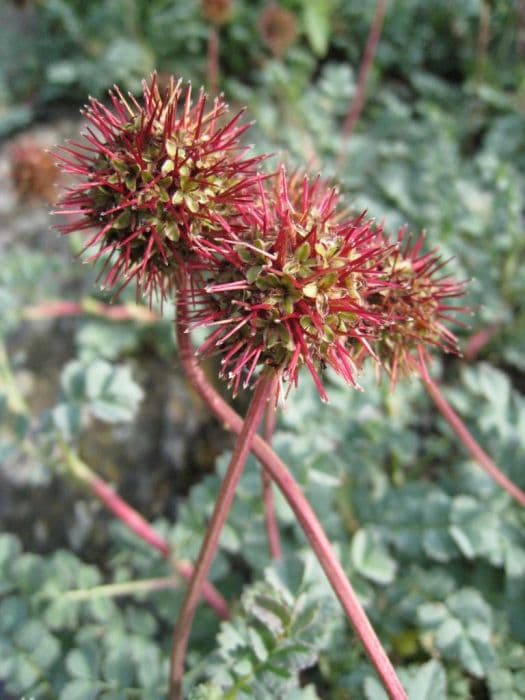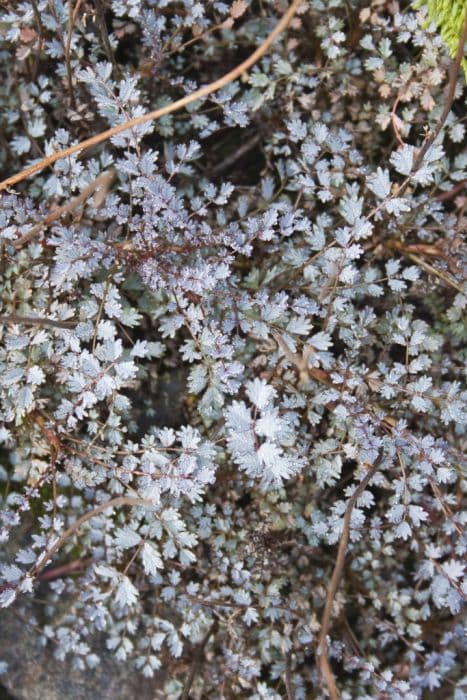Seagull Rambling Rose Rosa 'Seagull' (Ra)

ABOUT
The Rosa 'Seagull' is a variety of rose that carries a classic charm associated with these timeless flowers. It features a profusion of sizable blooms that are most commonly recognized for their semi-double to double forms, meaning each flower is packed with layers of petals. The petals showcase a creamy white hue, often with subtle tinges of pink at the edges, giving them a delicate and soft appearance. At the center of each bloom, bright yellow stamens stand out, providing a striking contrast against the pale petals. The foliage of the rose plant displays a lush green color, which forms an attractive backdrop for the flowers. The leaves are typically oval-shaped with a serrated margin, giving them a toothed appearance along the edges. These leaves are gathered in clusters along the canes, which are the long, arching stems typical of rose plants. The Rosa 'Seagull' plant presents a bushy and well-branched form, allowing for a dense and hearty presentation of both foliage and flowers. Over the flowering season, the plant will continue to produce new blooms, offering an extended period of visual interest and a gentle fragrance that can fill the surrounding air. This rose variety is also adorned with thorns, a common trait of rose plants, which can vary in size and density along the stems. These thorns are nature's way of protecting the plant and add an element of texture to the overall appearance. When in full bloom, the Rosa 'Seagull' becomes a focal point in gardens and landscapes, its clusters of creamy, soft flowers drawing attention and often becoming a haven for pollinators such as bees and butterflies. The contrast between the flowers and the green foliage, along with the plant's graceful structure, all contribute to its elegant and romantic presence.
About this plant
 Names
NamesFamily
Rosaceae
Synonyms
Seagull Rose
Common names
Rosa 'Seagull'
 Toxicity
ToxicityTo humans
Rosa 'Seagull', commonly known as Seagull rose, is not considered toxic to humans. It is a type of rose and in general, roses are not poisonous to people. They do not contain toxic compounds that would lead to serious poisoning if ingested. However, roses have thorns that can cause injury if handled improperly, and some people may experience mild allergic reactions to rose petals, pollen, or fragrance.
To pets
Seagull rose is also not considered toxic to pets. Roses are generally safe for animals, and there is no evidence to suggest that the Seagull rose variety has any toxic effects on pets if ingested. It's important to note that thorns can cause physical injury to pets if they try to chew on the plant. If a pet has a curious nature, it might be wise to keep it away from roses to prevent any potential injuries or choking hazards from the plant's woody stems and thorns.
 Characteristics
CharacteristicsLife cycle
Perennials
Foliage type
Deciduous
Color of leaves
Green
Flower color
White
Height
10 feet (3 meters)
Spread
6 feet (1.8 meters)
Plant type
Shrub
Hardiness zones
5
Native area
Europe
Benefits
 General Benefits
General Benefits- Aesthetic Appeal: The Rosa 'Seagull' adds beauty to any garden with its white or light pink flowers that bloom in abundance.
- Pollinator Attraction: It attracts bees, butterflies, and other pollinators, which are essential for the pollination of many plants and the overall health of the ecosystem.
- Landscape Enrichment: Seagull rose can be used in various garden designs, including borders, hedges, and as a spectacular climbing feature over arches and pergolas.
- Fragrance: The flowers emit a pleasant fragrance that can create a soothing and relaxing atmosphere in outdoor spaces.
- Versatility: Seagull rose is suitable for a range of soil types and garden conditions, making it a flexible choice for many gardeners.
- Cultural Significance: Roses have a long history of symbolism and are often associated with love and beauty, which can add meaningful layers to a garden's narrative.
- Wildlife Habitat: Thick rose shrubs provide shelter and nesting sites for birds and small wildlife.
 Medical Properties
Medical PropertiesThis plant is not used for medical purposes.
 Air-purifying Qualities
Air-purifying QualitiesThis plant is not specifically known for air purifying qualities.
 Other Uses
Other Uses- Crafting - Petals of the Rose 'Seagull' can be used in crafting activities, such as making natural dyes for fabrics or homemade paper for a touch of elegance and color.
- Gastronomy - The petals of roses can be crystallized with egg whites and sugar to create elegant edible decorations for desserts and cakes.
- Perfumery - Rose 'Seagull' petals can be distilled or used as key ingredients in creating natural perfumes or scented oils for their aromatic properties.
- Artistic - Roses can be pressed and included in floral arrangements or used in artwork, like botanical prints or mixed media art, for their aesthetic appeal.
- Bath Products - Dried Seagull rose petals can be added to bath bombs, salts, or soaps for a luxurious bathing experience with a gentle, natural rose scent.
- Candle Making - The fragrance of Rose 'Seagull' can be extracted and incorporated into candles to provide a floral scent to living spaces.
- Cultural & Ceremonial - In some cultures, roses are used during ceremonies or given as symbols of love, respect, or remembrance for various events.
- Aromatherapy - The soothing scent of Rose 'Seagull' can aid in relaxation and stress relief when used in aromatherapy diffusers.
- Decoration - Rose hips, which form after the flowers bloom, can be dried and used in decorative wreaths or as part of a dried floral arrangement.
- Environment Enrichment - Both rose petals and rose hips provide enrichment when included in potpourri mixes, offering a natural fragrance to a room.
Interesting Facts
 Feng Shui
Feng ShuiThe Seagull Rose is not used in Feng Shui practice.
 Zodiac Sign Compitability
Zodiac Sign CompitabilityThe Seagull Rose is not used in astrology practice.
 Plant Symbolism
Plant Symbolism- Love: As with many roses, Seagull roses symbolize love and romantic feelings. Their beautiful blossoms have long been associated with the emotions of the heart.
- Beauty: The Seagull rose, with its exquisite and delicate petals, represents beauty in various forms—whether it's physical attractiveness or the inner beauty of a person's nature.
- Honor: Roses are often seen as a gesture of respect and honor, and the Seagull rose is no exception. Offering this rose can be a sign of admiration for someone's achievements or character.
- Devotion: The enduring nature of rose blooms is reflective of devotion and commitment, making the Seagull rose a symbol for unwavering affection and loyalty.
- Mystery or Secrecy: Historically, roses have been a symbol of confidentiality. The term 'sub rosa' (under the rose) indicates secrecy. Therefore, the Seagull rose might represent an enigmatic situation or relationship.
- New Beginnings: The emergence of a rose's bud signifies birth and newness. Likewise, the Seagull rose can symbolize the start of something fresh, such as a relationship or project.
 Water
WaterClimbing Roses should be watered deeply once a week, providing about 1 to 1.5 gallons of water each time. It is critical to avoid overhead watering to prevent leaves from getting wet and developing fungal diseases. Instead, water directly at the base of the plant. During the hot summer months, you may need to water twice a week, especially if the soil is fast-draining or the weather conditions are particularly dry. Reducing the watering frequency as the weather cools in fall is vital to help the plants prepare for dormancy.
 Light
LightClimbing Roses thrive best in full sunlight where they can receive at least 6 to 8 hours of direct sun each day. An ideal spot would be one that provides morning sun, which is less intense and helps dry any dew on the leaves, reducing the chance of disease. These roses can handle some light afternoon shade, especially in very hot climates, but too much shade can diminish blooming and weaken the plant.
 Temperature
TemperatureClimbing Roses prefer a temperature range between 65 to 75 degrees Fahrenheit, but they can survive in temperatures as low as 20 degrees and as high as 90 degrees Fahrenheit. The ideal conditions for vigorous growth and optimal blooming are moderate spring and fall temperatures. Frequent fluctuations or extreme temperatures outside of their comfort range can lead to poor performance and reduced blooms.
 Pruning
PruningPruning Climbing Roses is essential to maintain shape, encourage new growth, and improve air circulation. Prune in late winter or early spring before new growth starts, removing dead or damaged canes and thinning out overcrowded areas. Aim to prune about one-third of the plant, cutting canes at a 45-degree angle just above an outward-facing bud. Pruning yearly promotes healthy plants and abundant blooms.
 Cleaning
CleaningAs needed
 Soil
SoilThe best soil mix for Seagull Rose is well-drained loam with organic matter like compost added. A pH between 6.0 and 7.0 is ideal for this plant.
 Repotting
RepottingSeagull Rose, being a garden plant, usually does not require repotting as it is grown outdoors in the ground.
 Humidity & Misting
Humidity & MistingSeagull Rose does best in moderate humidity conditions, typical of outdoor environments, without the need for specific humidity control.
 Suitable locations
Suitable locationsIndoor
Place in bright light, ensure air flow, water deeply, fertilize regularly.
Outdoor
Plant in full sun, well-drained soil, mulch, water deeply, prune.
Hardiness zone
5-9 USDA
 Life cycle
Life cycleSeagull Rose begins its life cycle as a dormant bare-root plant or container-grown specimen that's typically planted in spring or early fall. The plant then enters a vegetative stage, during which it develops leaves and stems; this is followed by the formation of buds. Given the right conditions of soil, water, and sunlight, the buds bloom into fragrant white or light pink flowers, characteristically seen in late spring to early summer. After pollination, which may involve insects or wind, the flowers develop into hips (fruit) that contain seeds. As autumn approaches, the plant starts to go dormant, conserving energy by shedding leaves and slowing down its growth. Finally, the rose may be propagated through cuttings or seeds, perpetuating the life cycle with new plants emerging from these propagules.
 Propogation
PropogationPropogation time
Spring-Early Summer
The most popular method for propagating Rosa 'Seagull', or the Seagull rose, is through softwood cuttings. This technique is commonly employed in late spring to early summer when new growth is soft and pliable. Cuttings about 6 to 8 inches (15 to 20 centimeters) long are taken from healthy, disease-free plants, ideally from the mid-section of a branch where growth hormones are concentrated. The lower leaves are removed, and the bottom cut is made just below a leaf node, where the concentration of natural rooting hormones is highest. The cut end is then dipped into a rooting hormone powder or gel to encourage root development and planted in a mixture of perlite and peat moss. The cuttings are kept in a well-lit area but out of direct sunlight and maintained in high humidity with consistent moisture until roots are established, which typically takes several weeks.









